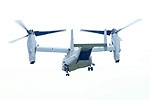Marine Ospreys reassure allies amid Russian saber-rattling
 The Marine Corps' MV-22 Osprey tiltrotor recently completed its first deployment to Romania as part of a multinational training exercise with European allies.
The Marine Corps' MV-22 Osprey tiltrotor recently completed its first deployment to Romania as part of a multinational training exercise with European allies.
The aircraft's deployment sent a strong message about U.S. commitment in Eastern Europe, calming allies as they work to counter Russian saber-rattling, said Brig. Gen. Norm Cooling, the deputy commander of Marine Corps Forces Europe and Africa.
"Exercises like Atlantic Resolve reassures our allies and deters [Russian President Vladimir] Putin in what he is doing," Cooling said, referring to a host of Marine training initiatives involving NATO allies, including operations by the Black Sea Rotational Force in Romania.
Escalating tensions in the region and ongoing intervention by Russia in Ukraine has some former Eastern Bloc countries — today close U.S. allies — nervous.
"If it is of concern to our allies, it should concern us because of our Article Five obligations," Cooling added, referring to the NATO agreement under which U.S. forces are obligated to respond to an attack on one of our allies. "Ideally Russia is not an adversary — if it turns around in Ukraine and gets back to their end of Cold War democratic transition to peaceful capitalism."
The deployment of three Marine Ospreys and a KC-130J Super Hercules with Marine Air-Ground Task Force Crisis Response-Africa from Spain to Romania is just one small facet of a growing effort by the U.S. military to reassure allies. While in Romania through late May to participate in Exercise Platinum Eagle — led by the Corps' Black Sea Rotational Force — Marines demonstrated the tiltrotor's capabilities by ferrying local and Bulgarian forces during training operations.
"I think they were very impressed with the Osprey," Cooling said. "We as Marines are still very impressed. You don't understand that until you see what is does in theater."
Using the Osprey helped Marines showcase crisis response capabilities with speed and range beyond any helicopter, all while maintaining the ability to land vertically in restrictive spaces.
Against the backdrop of larger-scale exercises in Eastern Europe that include large U.S. Army convoys, the deployment of heavy armor like M1A2 Abrams tanks, and even Air Force A-10 Thunderbolt jets, the Osprey may be a minor Russian worry.
"From Russia's perspective Ospreys are not going to suddenly invade," said Sim Tack, a military analyst for Stratfor, a private geopolitical intelligence firm. "You would need an air campaign to clear the way for it to be useful in this scenario."
The Osprey isn't hardened with armor or heavy weaponry and may not fare well in an anti-access environment, he said. He cited a case in January 2013 when Ospreys had to divert after taking a barrage of small arms fire during an embassy evacuation operation in Juba, South Sudan.
But the aircraft does much to reassure allies like Romania and Bulgaria, he said. That could be as important as actual fire power.
Those two nations are just a couple among many now living in the shadow of a Russia eagerly reclaiming its prominent role on the world stage. Lithuania and Estonia, also participating in military exercises with the U.S. this summer, are among those that gained independence when the Soviet Union dissolved, but are closely watching Russian intervention in Ukraine, worrying they could be next.
The region has seen a rapid increase in tensions and military buildups following the February 2014 outbreak of civil war in Ukraine between pro-independence and pro-Russian militias. Russia has denied widespread accusations they are sending arms and troops across the Ukrainian border. But what is clear is that Russia is placing more resources on its western border and the U.S. is engaging in an increasing number of large exercises just miles away.
Ukraine is critically important to Russia. Much of Russia's Black Sea Fleet, responsible for naval operations in the Black and Mediterranean seas, has been based there since it was part of the soviet Union. That puts critical Russian assets near Bulgaria and Romania, where hundreds of Marines are based.
Heightening tensions between the U.S. and Russia are recent incidents on the Black Sea. On May 30, a Russian fighter jet buzzed by the Navy's destroyer Ross. The Navy released video of the incident after Russian state media reported that the Ross was in or encroaching on territorial waters. Russian officials alleged that the fighters were scrambled to force the Ross to change course. Navy officials dispute all facets of the claim.
Tack said despite the recent highly-publicized incidents, it appeared that things have calmed since last summer, when the conflict in Ukraine was at its peak.
But that was Putin said in mid-June that he plans ramp up forces in direct response to U.S. operations.
RT, a Russian state-funded television network and online news outlet that broadcasts in English and several other languages, recently has published provocative headlines like "Russia warns NATO drills a 'problem' as U.S. attack planes buzz Poland" and "Russian military exercises 'logical response' to NATO troops on its border."
One of the stories states that, "Moscow says the military build-up at Russia's borders will have a negative long-term impact."
Some experts are likening the escalation of regional tensions to a rekindling of the Cold War. Even if open combat remains unlikely, the two sides seem to be edging towards proxy wars in countries like Ukraine as each backs opposing sides, experts say.